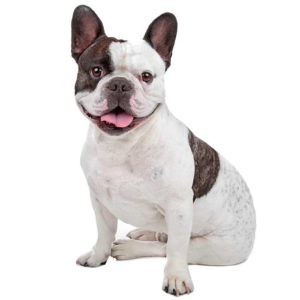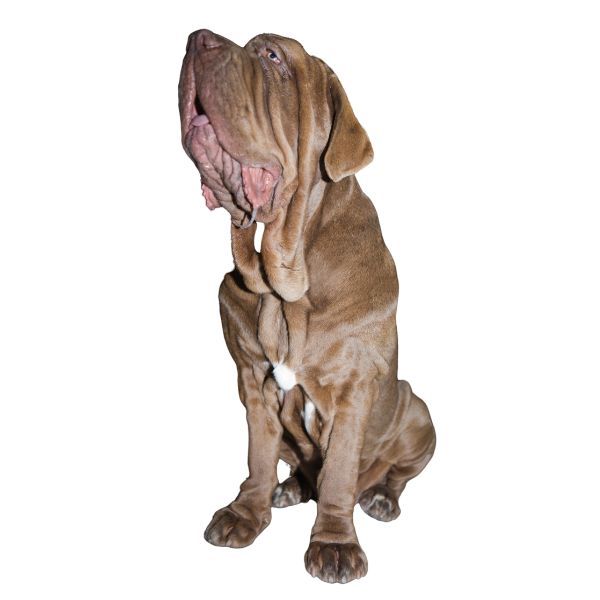Irish Wolfhound


| Recommended for | Experienced owners and families |
| Breed Classification | Hound group |
| Other names | Greyhounds or Ireland, Wolfdogs of Ireland |
| Lifespan | 6-10 years |
| Size | Giant |
| Temperament | Gentle, relaxed |
| Intelligence | High |
| Tendency to bark | Average |
| Maintenance Level | Medium |
| Health Risk | High probability of health issues during its lifetime, hence it is one of the more expensive breeds to insure. |
Insuring an Irish Wolfhound?
Get our award-winning Nose-to-Tail Cover with up to $30k annual benefit limit, up to 90% of eligible vet bills back, and no sub-limits.
Get a quick quote
Is this breed right for you?
Try our breed selector quiz to find out your best matching breed!
Insuring an Irish Wolfhound?
Get our award-winning Nose-to-Tail Cover with up to $30k annual benefit limit, up to 90% of eligible vet bills back, and no sub-limits.
Get a quick quote
Breed history of Irish Wolfhounds
The Irish Wolfhound has a lengthy ancestry, having been used to hunt large game for hundreds of years. Back in Roman times, there were accounts of large Greyhound-like dogs in Ireland, with ownership of these dogs reserved for the high born. In 391 AD, a Roman statesman wrote a letter of thanks to his brother for the gift of seven Irish hounds, noting that “all Rome viewed them in wonder.”
These imposing Irish dogs were prized in battle, as guardians of property and livestock, and as hunters of deer, elk, boar, and as their name attests, wolves. They became so popular overseas that in 1652 Oliver Cromwell issued a declaration prohibiting their exportation. But by the late 1700’s, when wolves and other big-game animals of Ireland were finally hunted to extinction, the dogs themselves soon followed suit. By 1836, the breed was included on a list entitled “Notices of Animals which have disappeared from Ireland.”
Fortunately, in 1862, former British army captain George Augustus Graham began scouring the country for remaining specimens of Ireland’s national hound. In order to revive the breed, Graham crossed the Irish Wolfhounds he found with Scottish Deerhounds, making it his life’s work to protect, standardize, and promote the breed.
Early settlers in Australia most likely transported some of these huge Irish hounds to their new country, where survival often depended on hunting, and in 19th century Irish Wolfhound crosses were used as kangaroo-hunting dogs. During the past twenty years many imports have come to Australia and played their part in the development of the breed. There are currently three Irish Wolfhound clubs in the states of NSW, Victoria and South Australia.

Physical description of Irish Wolfhounds
The Irish Wolfhound is one of the largest dog breeds in the world and the world’s tallest dog, with a minimum height of 79 cm for males and 71 cm for females. They can reach one meter in height and weigh up to 54kg. Although very muscular and strong, they aren’t the heaviest breed, being longer-legged and having a narrower frame than the Great Dane.
For a giant breed, the Irish Wolfhound looks athletic and well proportioned. A Greyhound-like breed, they are gracefully built, combining power and swiftness with keen sight.
The coarse double coat is rough and whiskery and its colours range from white to black, with shades of brindle, cream and dark grey. The hair is especially long over the brow and under the chin.
An Irish Wolfhound usually reaches full height between 18 and 24 months of age, but may not reach full maturity until 3 years or later.
| Weight range | 63 to 81 kg |
| Height range | Males 79 cm; females 71 cm |
| Colours | Grey, brindle, red, black, pure white, fawn or any colour that appears in the Deerhound |
| Coat length | Medium |
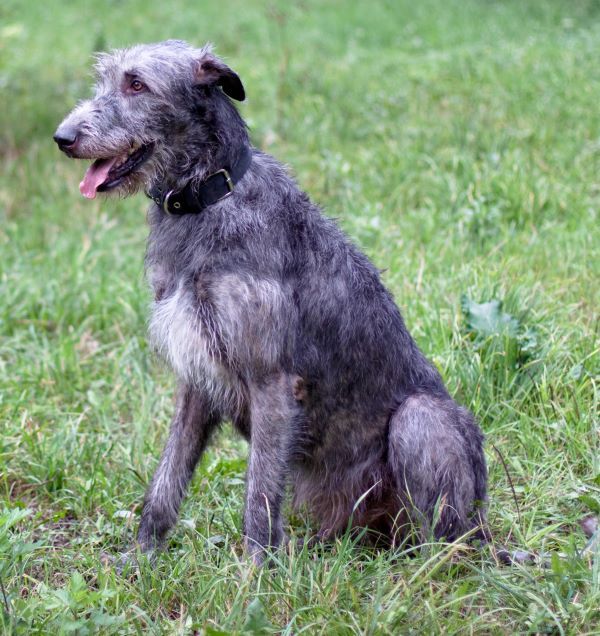
Irish Wolfhound personality and temperament
Everything is big with this breed, including its personality. Irish Wolfhounds are gentle giants who are always friendly and relaxed and make loyal, devoted companions.
Irish Wolfhounds are alert and brave, characteristics that were needed for hunting wolves. Their hunting instincts are still present and they may sometimes feel the need to chase other larger animals, which can make them unsuitable for first time dog owners. Apart from this, and the fact that are not suitable for a small flat or yard, they are a great family dog. A long wagging tail is probably the biggest “danger” for household objects and small ornaments.
Quiet by nature, the modern Irish Wolfhound isn’t considered to be an effective guard dog. They are not at all suspicious of strangers and aren’t aggressive toward them. However, their size, along with some barking, will deter all but the bravest potential intruders.
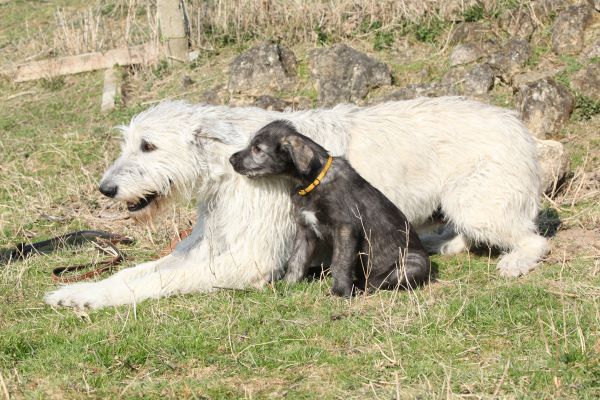
Irish Wolfhounds with kids and other pets
The typical Irish Wolfhound is completely trustworthy with children, but as with any breed, should not be left unsupervised with them. Kindness and patience are characteristics of the breed, and although they are sight hounds and excited by a chase, they usually don’t overreact to children.
Irish Wolfhounds are sociable animals and shouldn’t show aggression towards other dogs, particularly if they are given the right socialisation from a young age. But because of their hunting and chasing instincts, they are often not the best best match for cats or other small animals.
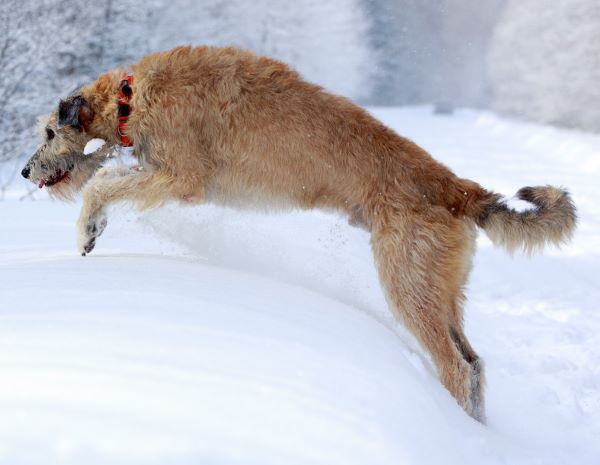
Irish Wolfhound training and exercise
Irish Wolfhounds love to rumble and run, and do require a fair amount of exercise every day. Adult dogs should be walked for 30 minutes a day, and as a large, galloping hound that can cover a lot of ground in a short time, they ideally need an open space away from traffic and livestock for free running exercise. Hilly areas are good for younger dogs to help with muscle development and strengthening of ligaments and joints.
Plenty of rest is also necessary for this breed, and particularly for puppies. However, wolfhounds can easily become “couch potatoes” if you let them, and when at home may spend most of their day lying at the back door.
Patience, consistency and kindness are essential when training a hound and the puppy will soon learn what is expected. Obedience classes are a great way to help you train your puppy and also provide him or her with valuable socialisation opportunities. Training with a professional trainer is highly recommended. Irish Wolfhounds prefer a gentle and soft handler that will guide them to do the right thing, and they respond best to encouragement and food rewards. They have a very sensitive side that doesn’t go at all with shouting or roughness.
Owners need to work on developing a quiet temperament in their dog from a young ageand to avoid rough play with pups and young adults as this could become a problem when the animal becomes fully-grown. Teaching them to walk nicely on lead is a must from puppyhood; once an adult, it will be hard to control the enormous Wolfhound who decides to pull you down the streets.
| Energy level | Moderate |
| Exercise requirements | Medium to high |
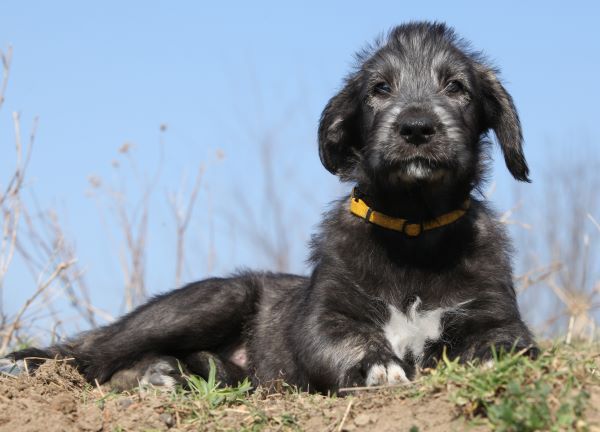
Irish Wolfhound feeding and nutrition
Feed the Irish Wolfhound a high-quality, well-balanced dog food appropriate to the dog’s age (puppy, adult, or senior), size and activity level. Be aware – you will be buying loads of dog food, not only to feed their large body mass, but also because they simply love food!
As they grow so quickly from tiny pups to giant adolescents, it is especially important to give young Irish Wolfhound an appropriate diet so they can develop at at normal rate. Be sure not to give them too much protein or calcium, as this can adversely increase their growth rate.
Owners of Irish Wolfhounds must be aware of the danger of bloat, where the stomach distends and twists. While the causes of bloat aren’t fully understood, veterinarians recommend multiple small meals per day and preventing vigorous exercise around mealtimes to help reduce the likelihood of its occurrence.
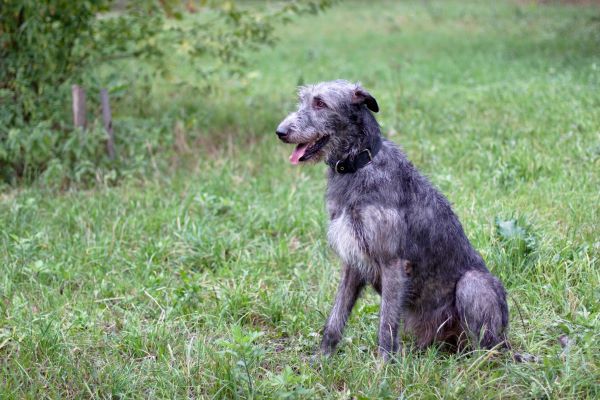
Irish Wolfhound care and grooming
The Irish Wolfhound has similar grooming requirements to any other rough-coated dog: regular brushing, bathing when required, and occasionally stripping out the dead hair. Daily brushing for 10 minutes with a stiff brush will maintain a clean and healthy coat.
Large dogs require good bedding and a trampoline or hammock-type of bed is recommended to protect the Irish Wolfhound’s joints, especially the elbows.
Health issues for Irish Wolfhounds
- Cancer is the number one killer of Irish Wolfhounds in the United States, the two most frequent types being osteosarcoma (bone cancer) and lymphosarcoma (arises in lymph nodes and in organs with lymphoid tissue, including the bone marrow, liver and spleen). Sarcomas are most common in middle-aged and older dogs, especially in large and giant breeds.
- Gastric Torsion, also know as bloat, is another leading causes of death in the Irish Wolfhound. It occurs when a gas-filled stomach flips over on itself, twisting the opening to the oesophaegus and intestines. Without immediate veterinary care, the affected dog will die a very painful death.
- Von Willebrand’s Disease is one of several genetic bleeding disorders that can occur in Irish Wolfhounds. It can cause serious complications both during and following surgery and may lead to death. Tests are available to determine if the condition is present in the dog.
 Elbow Hygroma, commonly known as bursas, is a common problem in Irish Wolfhounds and other giant breeds. Hygroma is the soft to firm swelling that occurs just behind the elbow, most commonlyd caused by trauma from lying on hard surfaces. Hygromas will resolve themselves spontaneously, and ordinarily, they cause no permanent damage. It is thought that a predisposition to hygromas may be hereditary because they seem to be seen more in some lines than in others.
Elbow Hygroma, commonly known as bursas, is a common problem in Irish Wolfhounds and other giant breeds. Hygroma is the soft to firm swelling that occurs just behind the elbow, most commonlyd caused by trauma from lying on hard surfaces. Hygromas will resolve themselves spontaneously, and ordinarily, they cause no permanent damage. It is thought that a predisposition to hygromas may be hereditary because they seem to be seen more in some lines than in others.- Hip Dysplasia is a hereditary condition common in many breeds where as the dog matures, the hip joints don’t grow correctly. Normal wear and tear can lead to lameness, crippling arthritis and severe pain. Some dogs become so lame and pain-ridden that surgery or euthenasia, is necessary.
- Osteochondrosis of the shoulder is primarily degeneration of the cartilage. which can lead to inflammation of the joint. Usually appearing between 4 to 7 months of age, the resulting lesion is termed osteochondritis dessicans. Signs of the condition include lameness, which becomes worse after exercise, and stiffness after rest. Surgery is usually necessary.
- Hypothyroidism is the most common hormone imbalance occurring in dogs. Also called “underactive thyroid”, it is characterised by a decrease of thyroid hormones, resulting in a slower metabolic rate. Found most often in middle-aged to older dogs, the average age at diagnosis is 7-years. It usually affects mid- to large-size breeds.
- Genetic eye conditions that can occur in the breed include Progressive Retinal Atrophy (PRA), and Juvenile Cataracts.
Not all conditions are covered by Pet Insurance. For details of Bow Wow Meow Pet Insurance cover, refer to the Product Disclosure Statement.
Free engraved pet ID tag on sign up3
Customer Satisfaction
21 day cooling off
Easy to use Pet Portal

GapOnly® in vet claims
MORE INFORMATION
Irish Wolfhound Clubs of NSW and SA: http://www.iw-aust.org.au/
The Irish Wolfhound Club of Victoria Inc: https://www.irishwolfhoundsvictoria.com/

